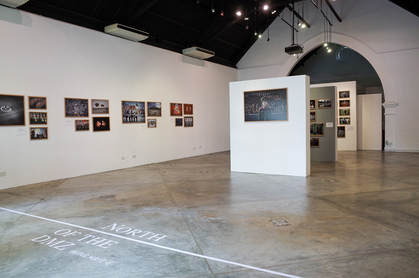-
From Current Issue
-
- Editor’s Letter Fire in the Heart
- Reviews I Gusti Ayu Kadek Murniasih
- Reviews 11th Seoul Mediacity Biennale: “One Escape at a Time”
- Dispatch Networked China
- One on One Monira Al Qadiri on Yukio Mishima
- Essays The rise of independent art spaces in pandemic-era Shanghai
- Features Tuan Andrew Nguyen
- Table of Contents
- Web Exclusives
- Archive
- Subscribe

R
E
V N
E
X
T
WONG MAYE-E, 2016, photographic print, 44.5 × 71.7 cm. On Tuesday, Feb. 16, 2016, a North Korean man carries his country’s national flag at the Pyongyang Indoor Stadium in Pyongyang, North Korea. Courtesy AP Photo/Wong Maye-E.
In her first solo exhibition, photojournalist Wong Maye-E presented over 70 works at Objectifs Centre for Photography and Film, taken during her current stint as lead photographer for The Associated Press (AP) in North Korea. Invariably referred to as “the hermit kingdom” and “one of the world’s most repressive regimes,” North Korea strictly supervises visiting journalists and mandates what and who may be documented. Wong’s exhibition, titled “North of the DMZ,” might therefore imply yet another dreary round of state-sanctioned images: gleaming weaponry, a well-drilled military, synchronized mass-celebrations, and the vacuous smiles of the country’s “maniacal” dictator, Kim Jong-un. While these indeed are among Wong’s imagery at Objectifs, her offbeat compositions and idiosyncratic punctuations of color and abstraction strip some of the veneer from North Korea’s politically curated fictions.
Wong has worked for AP since 2003. She first visited North Korea’s capital Pyongyang in 2013, shortly after the AP established its full bureau there, and she took over as AP’s lead photographer for the country following the departure of veteran photographer David Guttenfelder in 2014. Based in her native Singapore, Wong travels monthly to North Korea, to Pyongyang and beyond. She is accompanied always by an official government “minder” who directs her observations to stay within those authorized areas around Pyongyang that are intended to project prosperity—beyond which lie famine, poverty and prison labor camps.
WONG MAYE-E, 2015, photographic print, 68.3 × 101.5 cm. North Korean school girls holding brooms bow to pay their respects toward a mural which shows the late North Korean leader Kim Il Sung delivering a speech, before sweeping the area surrounding this mural on Tuesday, Dec. 1, 2015, in Pyongyang, North Korea. Courtesy AP Photo/Wong Maye-E.
Without free access to her beat—she covers “news and everyday life”—Wong allows herself to be led and, though her creative freedom is limited, she draws on elements of rhythm and contrast to energize—and humanize—the explicitly propagandist imagery. Her photographs at Objectifs are titled simply with brief descriptions and dates, and are hung in related groupings that include portraits, urban street scenes and the ubiquitous soldiers. Among these are a half-dozen works depicting North Korea’s famous quasi-military gatherings, which involve thousands of perfectly synchronized participants. A stifling anti-American rally (2015), a choreographed children’s ensemble (2013), and a trippy “mass dance party” (2016) are all projected as entrancing Escher-like tessellations.
In contrast to this political theater, Wong’s photographs more often reveal some odd angle, peculiar cadence or spontaneity that betray genuine intimacy, such as the impromptu whisper between two children—one wearing glorious pink—captured in a 2016 image. She captures quirky, sometimes surreal moments, such as women (workers in the nation’s largest textile factory) gossiping in a sauna (2014); a seaside children’s camp bathed in glowing colors (2014); euphoric visitors on vintage amusement park rides (2014); and volleyballers against the painted backdrop of a swan-lake mural (2015). Wong also collects portraits of subjects who (keeping in mind they are in the presence of Wong’s accompanying “minder”) are obliged to perform their roles quite seriously. One of these is a distant shot of a traffic policewoman who stiffly directs cars from within a white bull’s-eye circle, accompanied by her attenuated shadow—an abstract masterpiece of government staging. Yet in another dozen or so quiet character studies, which include a very young soldier, a gnarled village elder, beer girls, an Olympic medalist and pristine uniformed workers, Wong succeeds in capturing instances of fumbled self-reference, where restraint is tempered and faces gentled.
Interspersed among the exhibition were austere snowy landscapes, nearly monochromatic studies of country bridges, carts loaded with cabbages, and an aerial view of a gleaming river—but Wong excels at capturing sparks of human vitality, and her off-kilter photographs of children on roller blades reflected in a puddle (2014), and of a cherubic boy gripping a toy gun (2015), are the unlikely but recognizable progeny of Henri Cartier-Bresson’s humanist, expressionistic streetscapes. The wall-caption commentary that accompanies “North of the DMZ” reminds us that Wong’s images are analyzed and dissected for what they may reveal, or suppress—both in and outside of North Korea—and that journalists there walk a fine line between objectivity and complicity. In attempting to decipher an authoritarian culture of subjugation, Wong crafts her own unique vision of journalistic integrity—one that simply asks us to ponder these unimaginable lives.
Wong Maye-E’s “North of the DMZ” is on view at Objectifs Centre for Photography and Film, Singapore, until October 15.






